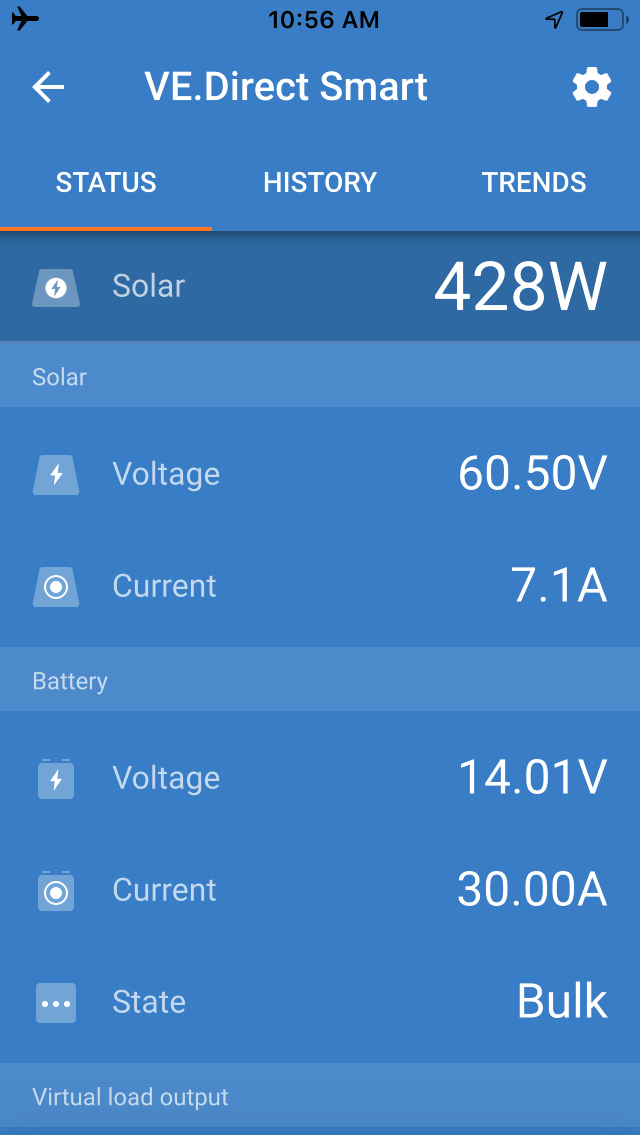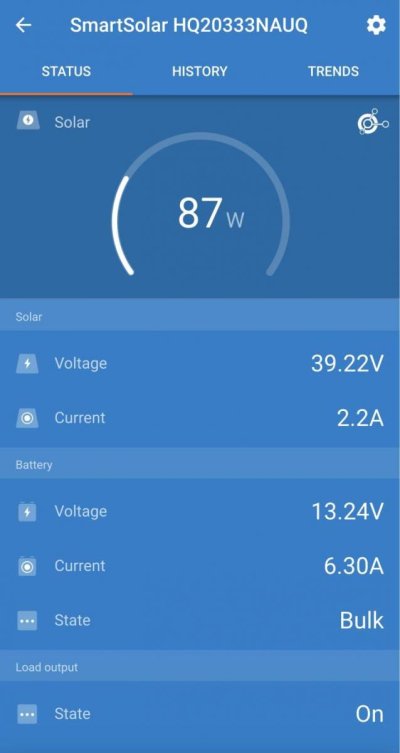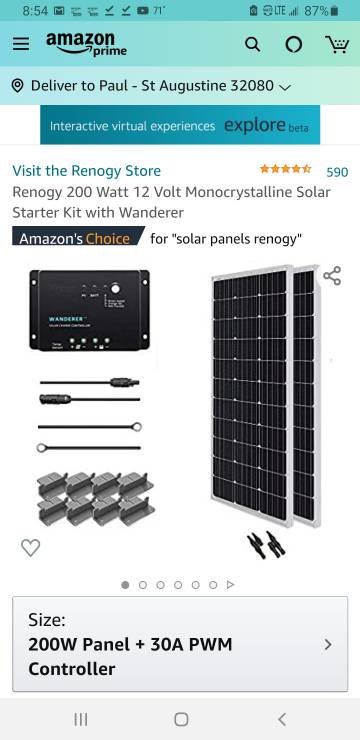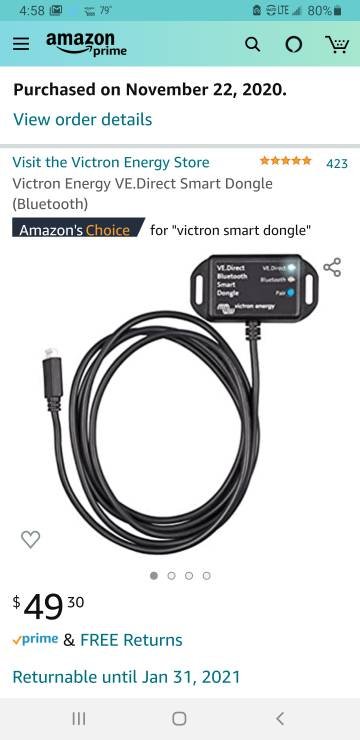You are using an out of date browser. It may not display this or other websites correctly.
You should upgrade or use an alternative browser.
You should upgrade or use an alternative browser.
Solar help
- Thread starter Pmcsurf1
- Start date
The friendliest place on the web for anyone who enjoys boating.
If you have answers, please help by responding to the unanswered posts.
If you have answers, please help by responding to the unanswered posts.
psneeld
Guru
I have a 400W Renology setup (not a kit as I started with a 200W kit but upgraded warious parts like to a MPPT controller).
Very satisfied after 4 years.
2 fixed panels on hinges so there is limited adjustment to the sun angle...2 portable so I can put them anywhere and angle them at the sun.
Some days I have decent output right up until sunset when pointing straight at the sun.
Very satisfied after 4 years.
2 fixed panels on hinges so there is limited adjustment to the sun angle...2 portable so I can put them anywhere and angle them at the sun.
Some days I have decent output right up until sunset when pointing straight at the sun.
Renogy is a pretty good brand which came from obscurity 4-5 years ago and now has a wide range of DC electrical systems at very reasonable prices.
The package is ok, but you can save quite a bit of money by buying individual components (price them on Amazon and see) as well as upgrade to a better MPPT controller- Renogy or Victron (one of the best). The money you will save on the individual components should pay for the upgraded controller.
David
The package is ok, but you can save quite a bit of money by buying individual components (price them on Amazon and see) as well as upgrade to a better MPPT controller- Renogy or Victron (one of the best). The money you will save on the individual components should pay for the upgraded controller.
David
rsn48
Guru
- Joined
- Feb 18, 2019
- Messages
- 2,019
- Location
- Canada
- Vessel Name
- Capricorn
- Vessel Make
- Mariner 30 - Sedan Cruiser 1969
I strongly suggest you watch some of the videos on Will Prowse's vlog, he is self taught and very good. He is into batteries, particularly lithiums and solar power. He reviews cheap versus expensive solar panels and comes up with some surprises. He also has recommendations for panels.
https://www.youtube.com/channel/UCoj6RxIAQq8kmJme-5dnN0Q
https://www.youtube.com/channel/UCoj6RxIAQq8kmJme-5dnN0Q
Pmcsurf1
Senior Member
I'll check him out for sure. ThanksI strongly suggest you watch some of the videos on Will Prowse's vlog, he is self taught and very good. He is into batteries, particularly lithiums and solar power. He reviews cheap versus expensive solar panels and comes up with some surprises. He also has recommendations for panels.
https://www.youtube.com/channel/UCoj6RxIAQq8kmJme-5dnN0Q
Pmcsurf1
Senior Member
Thanks for the heads up about the controler.Renogy is a pretty good brand which came from obscurity 4-5 years ago and now has a wide range of DC electrical systems at very reasonable prices.
The package is ok, but you can save quite a bit of money by buying individual components (price them on Amazon and see) as well as upgrade to a better MPPT controller- Renogy or Victron (one of the best). The money you will save on the individual components should pay for the upgraded controller.
David
I ordered from Amazon
Vicron 100v 20 amp mppt controler
Victron smart battery sensor BT
2 Renogy 100 watt flexible panels
100' 10awg marine wire with connectors and crimping tool.
I'm figuring on 12 amps. Hopping that will cut back on generator time. Maybe add another panel later.
My fridge is using 5 to 6 amps so I'm hoping this solar system and cover that.
Consider cancelling the battery sensor and order a real battery monitor, either the Victron BMV 700 or the Renogy Battery Monitor. Either are shunt based meters that display real amperage used either intantaneous or amp hours over time. Amp hour usage is very important at managing your batteries. They also display voltage.
David
David
Comodave
Moderator Emeritus
- Joined
- Jul 2, 2015
- Messages
- 22,444
- Location
- Au Gres, MI
- Vessel Name
- Black Dog
- Vessel Make
- Formula 41PC
I am in the process of replacing my house bank and am going with a Balmar Sg200 SOC meter. It has some really good reviews so time will tell.
Pmcsurf1
Senior Member
You're right.Consider cancelling the battery sensor and order a real battery monitor, either the Victron BMV 700 or the Renogy Battery Monitor. Either are shunt based meters that display real amperage used either intantaneous or amp hours over time. Amp hour usage is very important at managing your batteries. They also display voltage.
David
About this item
The Victron Smart Battery Sense is a wireless battery voltage and temperature sensor for Victron MPPT Solar Chargers.
With voltage and temperature sense in place, batteries will be better charged; improving charging-efficiency and prolonging battery life
It uses VE.Smart Network - a wireless technology based on Bluetooth Smart.
Dimensions: 2 x 3 x 3 inches
This comes with 5 year Warranty Guarantee
Volts and temp only. What? I assumed it showed amps.
Pmcsurf1
Senior Member
I did an Amazon search for balmar sg200 soc. Nothing came up. What is it?I am in the process of replacing my house bank and am going with a Balmar Sg200 SOC meter. It has some really good reviews so time will tell.
Comodave
Moderator Emeritus
- Joined
- Jul 2, 2015
- Messages
- 22,444
- Location
- Au Gres, MI
- Vessel Name
- Black Dog
- Vessel Make
- Formula 41PC
It is Balmars State of Charge meter. There is a review of it on marinehowto.com. I found it on Amazon.
Pmcsurf1
Senior Member
Comodave
Moderator Emeritus
- Joined
- Jul 2, 2015
- Messages
- 22,444
- Location
- Au Gres, MI
- Vessel Name
- Black Dog
- Vessel Make
- Formula 41PC
Sorry, I am not familiar at all with Victron stuff. I searched Amazon for SG200 Balmar and it came up.
- Joined
- Apr 15, 2008
- Messages
- 13,738
- Location
- California Delta
- Vessel Name
- FlyWright
- Vessel Make
- 1977 Marshall Californian 34 LRC
I just did a Renogy MPPT 400W install on FlyWright. Here's a link to my Quarantine Cruise thread with the installation of my system, all bought as components, not a system. I really like the Bluetooth interface option that works well with my tablet or phones.
https://www.trawlerforum.com/forums/s28/my-quarantine-cruise-2020-a-49739-6.html
I'm very happy so far with mine but have not yet tried a "long cruise" check. I know that I need either an 0:30-1:00 boat run or a 1 hr genset run during cooking to supplement the solar. My typical daily electron budget is about 180-200AH on a 660 AH bank. Cooking, refrigerators and hot water are the greatest demands on my boat by far.

https://www.trawlerforum.com/forums/s28/my-quarantine-cruise-2020-a-49739-6.html
I'm very happy so far with mine but have not yet tried a "long cruise" check. I know that I need either an 0:30-1:00 boat run or a 1 hr genset run during cooking to supplement the solar. My typical daily electron budget is about 180-200AH on a 660 AH bank. Cooking, refrigerators and hot water are the greatest demands on my boat by far.
Pmcsurf1
Senior Member
Question about the app. Yours reads 428 wattsI installed a Victron MPPT controller with the Victron Direct Dongle and have been very satisfied. Here is what the display looks like (Iphone)

60 volts
7 amps
Is that what you're using or what the panel is making? Mine shows numbers but my inverter monitor shows I'm discharging the same 7 amps as I was before the install.
Btw how many panels?
NWSeadog
Senior Member
Question about the app. Yours reads 428 watts
60 volts
7 amps
Is that what you're using or what the panel is making? Mine shows numbers but my inverter monitor shows I'm discharging the same 7 amps as I was before the install.
Btw how many panels?
The solar numbers are what the panels are making. The battery numbers are what is being supplied to the battery bank from the MPPT controller. The controller sits between the panels and the battery bank so it has no knowledge of what I'm drawing from the bank. I have a seperate SOC meter that provides me with battery usage that would also include the inverter.
The panel array consists of three Renogy 175 Watt flexible panels. I went with a series configuration to limit wire size between the panels and the controller that is located in the engine compartment.
I am surprised that it is receiving 61 volts and 7 amps from the three panels. That is about 20 volts from each panel wired in series and is much higher than the Vmp that the controller is trying to maintain (typically 16-17 V) and very close the the maximum Voc value of 21 V. At 20V I would have expected the current to be much lower than 7 amps.
But I can't argue with success although I don't like 3 or more panels wired in series. That is too high of a voltage for most DC wiring and components. For example, most DC surface mount circuit breakers are limited to 48V.
David
But I can't argue with success although I don't like 3 or more panels wired in series. That is too high of a voltage for most DC wiring and components. For example, most DC surface mount circuit breakers are limited to 48V.
David
H2O_Doc
Veteran Member
I have 200W Renogy with their PWM controller. I've seen 170W maximum in the summer, and not much more than 100W in the Winter. I think they make good equipment. I like their bluetooth app, despite not thinking I wanted it. It's really handy to be able to check output, battery state using your phone.
Pmcsurf1
Senior Member
I think I'm running correctly. I got 21 volts at each panel and 18 volts at the controller loss of 3 volts over 40 plus feet of cable sound okay to you guys?
I used 10 awg.
I used 10 awg.
Last edited:
NWSeadog
Senior Member
I am surprised that it is receiving 61 volts and 7 amps from the three panels. That is about 20 volts from each panel wired in series and is much higher than the Vmp that the controller is trying to maintain (typically 16-17 V) and very close the the maximum Voc value of 21 V. At 20V I would have expected the current to be much lower than 7 amps.
But I can't argue with success although I don't like 3 or more panels wired in series. That is too high of a voltage for most DC wiring and components. For example, most DC surface mount circuit breakers are limited to 48V.
David
The open circuit voltage (Voc) on each panel is rated at 23.9V and a Vmp of 19.5V. The solar panel side of the MPPT controller is rated at a maximum of 100V. This is where MPPT controllers shine. The high voltage is only in dedicated wiring between the panels and the controller. The problem with lower voltage configurations is the need for bigger wire in order to minimize voltage drop.
I think I'm running correctly. I got 21 volts at each panel and 18 volts at the controller loss of 3 volts over 40 plus feet of cable sound okay to you guys?
I used 10 awg.
Looking back you have two 100 watt panels wired in parallel, right? A 3 volt drop is awful. With 10 gauge wire 40' long with about 12 amps it can't be that high. It should be about 1 volt or 1/2 volt if you wired them in series.
David
Pmcsurf1
Senior Member
Series with 10 awg.Looking back you have two 100 watt panels wired in parallel, right? A 3 volt drop is awful. With 10 gauge wire 40' long with about 12 amps it can't be that high. It should be about 1 volt or 1/2 volt if you wired them in series.
David
Pmcsurf1
Senior Member
Snapshot. 10 am sunny but cool temperature. 59 degrees. Captiva FL (sw fl). 2 100 watt renogy, 100 20 victron mppt.
Question
Solar shows 87 watts, 39 volts, 2.2 amps. Thats what the solar is making.
Battery shows a positive 6.3 amps. What is that number? The amps the battery is loosing or putting out? Wouldn't that be a negative number if my solar is only making 2.2 amps?

Question
Solar shows 87 watts, 39 volts, 2.2 amps. Thats what the solar is making.
Battery shows a positive 6.3 amps. What is that number? The amps the battery is loosing or putting out? Wouldn't that be a negative number if my solar is only making 2.2 amps?

GoneFarrell
Guru
The 6.3 amps is what's going into your battery bank at 13.24 volts from the Victron. That's the output side of the Victron after converting the input volts/amps to something your batteries can digest.
Swipe left to see history graphs, if you haven't done so already.
Swipe left to see history graphs, if you haven't done so already.
NWSeadog
Senior Member
The 6.3 amps is what's going into your battery bank at 13.24 volts from the Victron. That's the output side of the Victron after converting the input volts/amps to something your batteries can digest.
Swipe left to see history graphs, if you haven't done so already.

Bkay
Guru
- Joined
- Aug 8, 2018
- Messages
- 580
- Location
- United States
- Vessel Name
- Wingspan
- Vessel Make
- Aluminum Catamaran
Here's how I have interpreted that - tell me if I'm mistaken here...
The panels are producing 87 watts. Divide that by 39.22 volts to get 2.2 amps. produced by the solar panels.
The batteries are in bulk mode and the controller is sending 13.24 volts to the battery. So the same 87 watts divided by 13.24 volts is 6.57 amps.
The difference between 6.57 amps and the 6.3 amps the controller is actually sending to your batteries is accounted for by some inefficiency or the power to run the controller. Is that more or less right?
The panels are producing 87 watts. Divide that by 39.22 volts to get 2.2 amps. produced by the solar panels.
The batteries are in bulk mode and the controller is sending 13.24 volts to the battery. So the same 87 watts divided by 13.24 volts is 6.57 amps.
The difference between 6.57 amps and the 6.3 amps the controller is actually sending to your batteries is accounted for by some inefficiency or the power to run the controller. Is that more or less right?
Similar threads
- Replies
- 1
- Views
- 236
- Replies
- 20
- Views
- 828
- Replies
- 6
- Views
- 682
Latest posts
-
-
-
Seeking Navionics CF Card Eastern US and rivers
- Latest: Sanford Gentry
-
-
-
-
-


